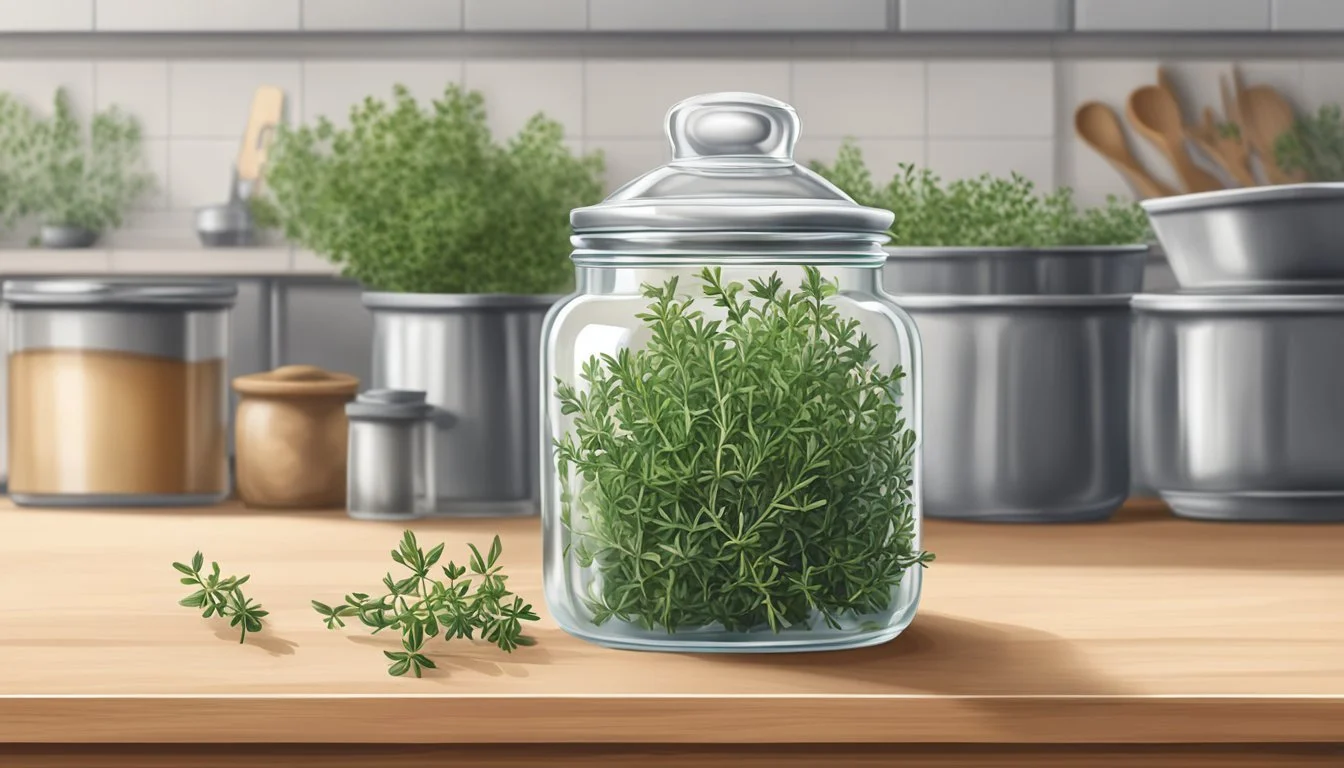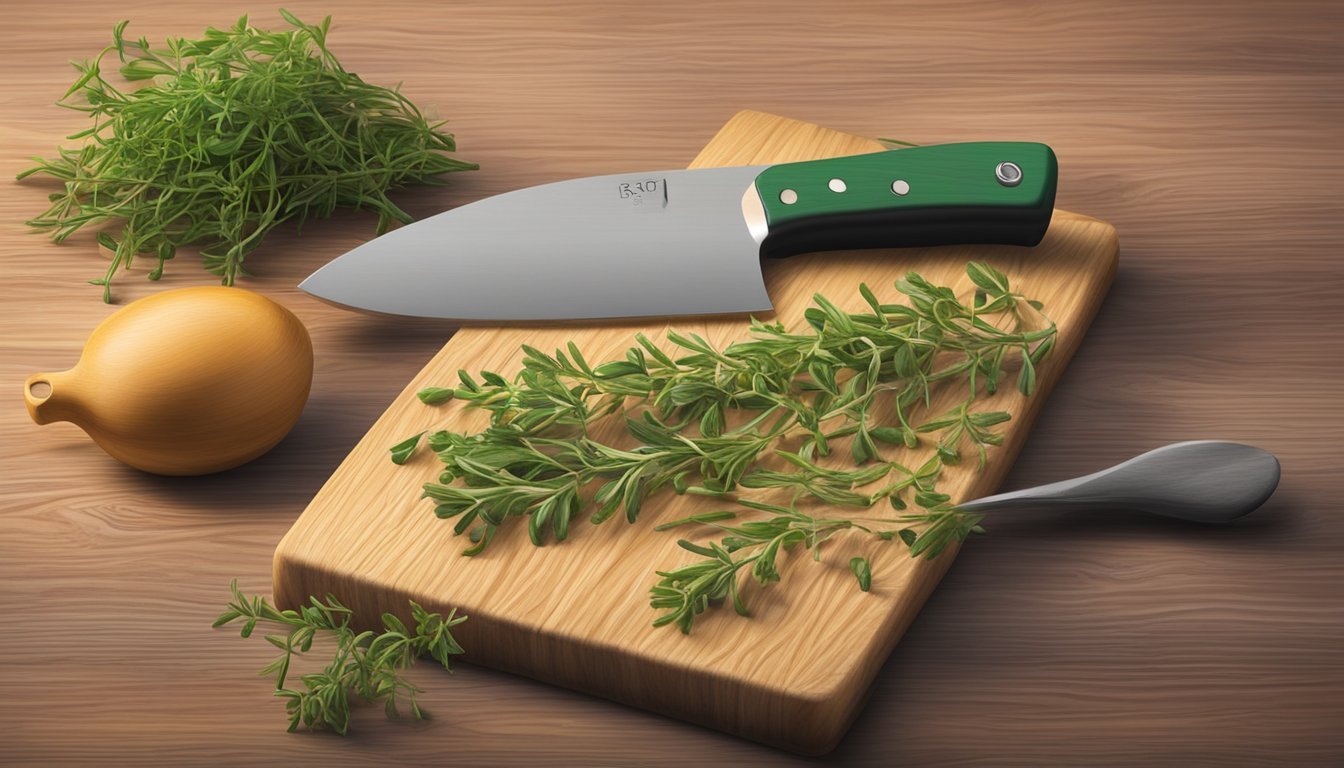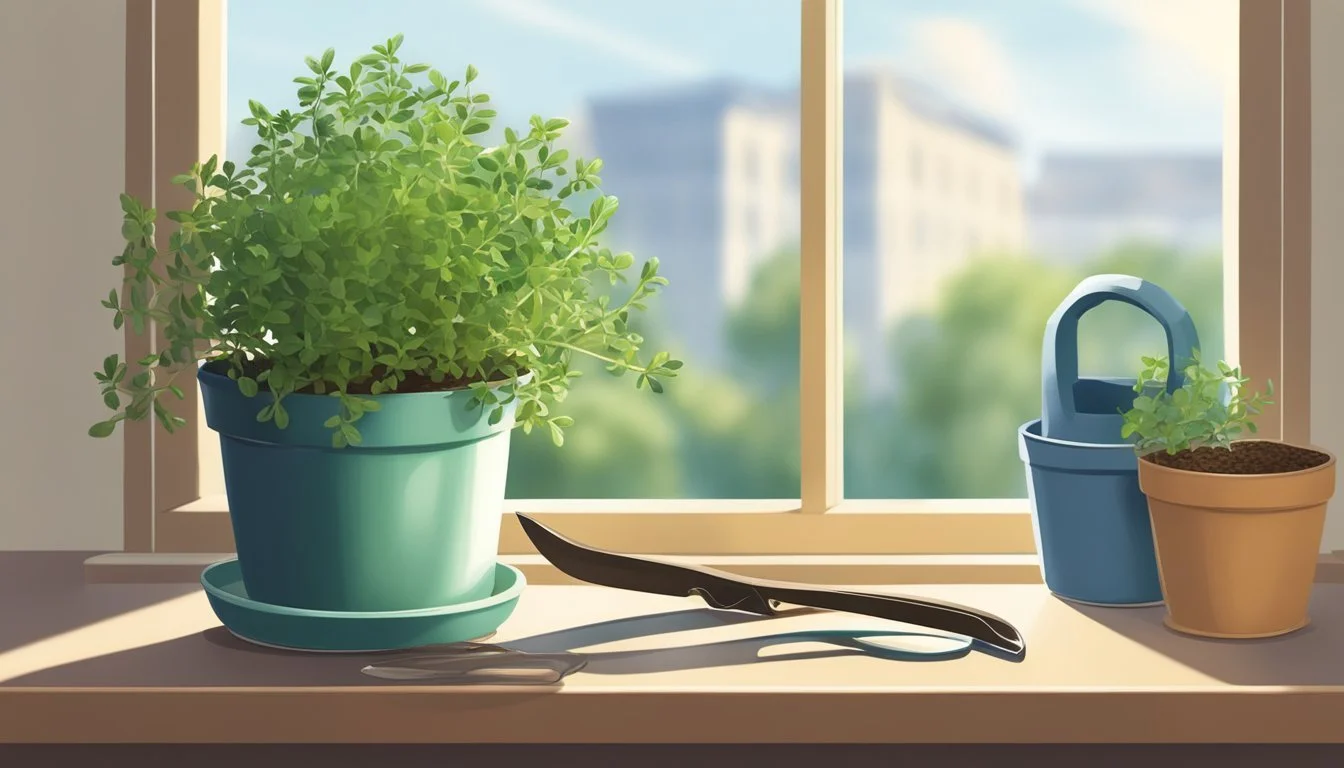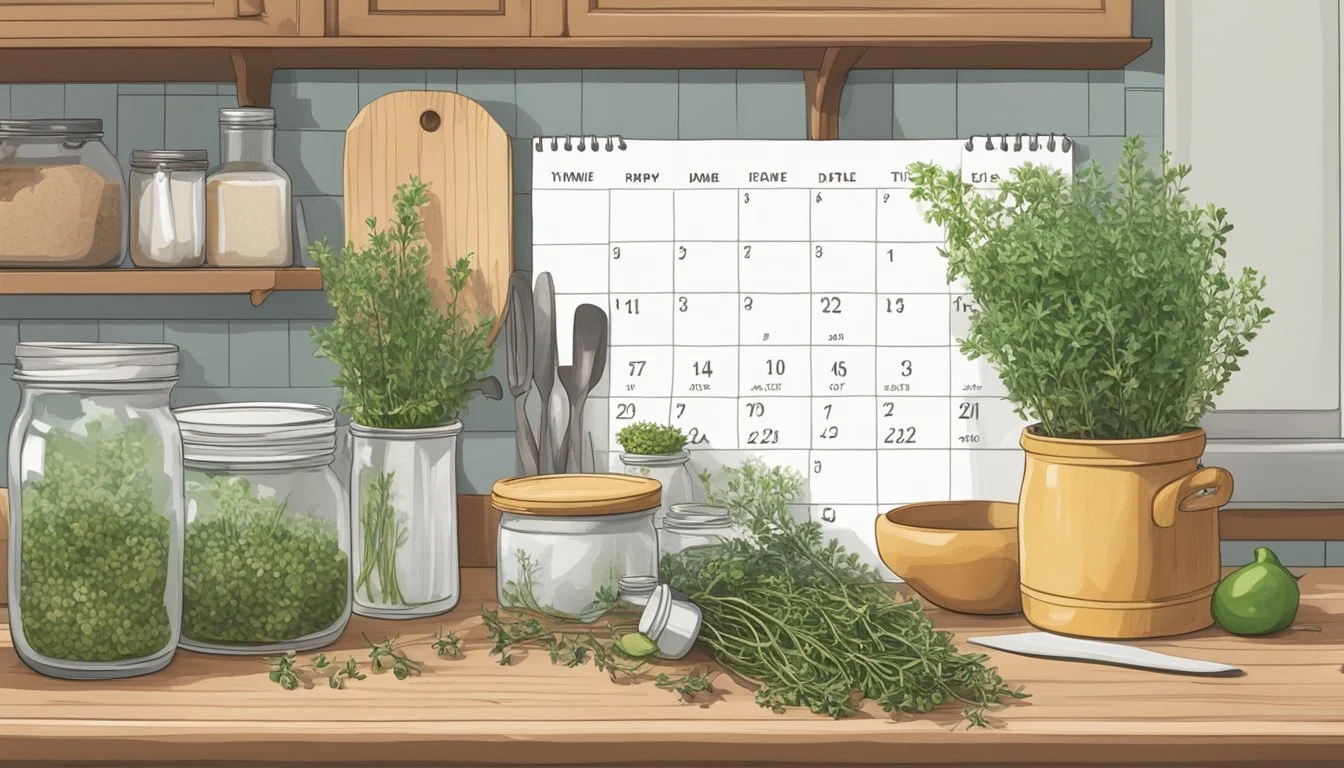How Long Does Thyme Last?
Shelf Life and Storage Tips
Thyme, an herb cherished for its aromatic and culinary properties, has a variable shelf life that depends predominantly on whether it is fresh or dried. Fresh thyme typically maintains its quality for about 1 to 2 weeks when stored properly in the refrigerator. Its longevity can be affected by factors such as moisture and how it is packaged. By ensuring thyme is kept in optimal conditions—dry and cool—it is possible to preserve its freshness and flavor.
Dried thyme, on the other hand, enjoys a considerably longer shelf life owing to the dehydration process it undergoes, which effectively extends its usability. When stored in a cool, dark, and dry place, such as a pantry or cupboard, dried thyme can last between 6 to 8 months while still retaining most of its flavor. Refrigeration of dried thyme isn't necessary but can further prolong its freshness when stored in an airtight container, with some sources suggesting it can last 1 to 2 years under refrigeration.
Understanding the proper storage methods for thyme can significantly influence its shelf life and the potency of its flavor when used in cooking. It's important to inspect the herb for signs of spoilage or loss of aroma to determine its freshness. With proper maintenance, both fresh and dried thyme can be relied upon to impart their signature earthy and minty notes to a wide variety of dishes over time.
Understanding Thyme
Thyme is a versatile and widely used herb that plays a significant role in culinary, medicinal, and aromatic applications. Its potency and fragrant aroma stem from the essential oils present in its leaves, making it a permanent fixture in various cooking and health regimens.
Types of Thyme
There are several varieties of thyme, each with unique characteristics. The most common type is Thymus vulgaris, an evergreen subshrub with fragrant leaves that is preferred for culinary use. Besides common thyme, lemon thyme is another popular variety, favored for its citrus scent. Thyme plants are perennial and can be grown in pots or gardens. They often attract bees with their flowers.
Culinary Uses
Thyme has a robust flavor that complements a variety of dishes. Its leaves can be used fresh or dried, and it's often added to soups, stews, and sauces. Thyme pairs well with vegetables, eggs, poultry, and seafood. To retain its aroma and taste, it is typically harvested just before the plant flowers.
Health Benefits
Thyme is not only valued for its culinary applications but also its health benefits. It contains compounds that have been studied for their antibacterial and antioxidant properties. Consuming thyme can aid in digestion and it's also used in various forms, such as an oil or tea, to alleviate coughs and sore throats.
Factors Affecting Freshness
Preserving the freshness of thyme hinges on several specific factors including temperature, humidity, and proper storage techniques. These elements collectively influence the quality and longevity of the herb, emphasizing the importance of optimal conditions to maintain its potent flavor and aromatic properties.
Temperature and Humidity
Maintaining a consistent, cool temperature and moderate humidity is crucial for the freshness of thyme. Room temperature can keep fresh thyme viable for only 1-3 days, but refrigeration extends this period to up to two weeks due to a colder and more stable environment. Furthermore, high humidity combined with poor air circulation can lead to moisture buildup, resulting in mold and a slimy texture.
Fridge: Ideal for short-term storage, preserving freshness and preventing spoilage.
Freezer: Suitable for long-term preservation, can keep frozen thyme viable for months but may slightly affect quality.
Proper Storage Techniques
Properly storing fresh thyme requires techniques that limit exposure to detrimental elements. Wrapping the thyme in a slightly damp paper towel and placing it in an airtight container or a sealed plastic bag ensures the right balance of moisture and air circulation, critical in preventing the delicate leaves from wilting or drying out.
Path to extended freshness:
Prepare thyme (rinse and pat dry)
Wrap in damp paper towel
Store in airtight container or sealed plastic
Regularly check moisture level (change towel if necessary)
Place in fridge or freezer accordingly
Signs of Spoilage
Recognizing when thyme has gone bad is essential for food safety. The key signs of spoilage include:
Discoloration: Leaves turning brown or yellow
Wilted Leaves: Lacking firmness and structure
Mold: White or green fuzzy spots
Off Smell: An unusual or sour odor
Slimy Texture: Leaves become wet and stick together
Discarding thyme that exhibits any of these characteristics is crucial, as consuming spoiled herbs can pose health risks.
Preserving Fresh Thyme
Proper preservation techniques can significantly extend the shelf life of fresh thyme. Using methods like refrigeration, freezing, and drying helps maintain the flavor and usability of thyme for various durations.
Refrigeration Methods
In the refrigerator, fresh thyme can be kept fresh for 1-2 weeks. For optimal storage, one should:
Wash and pat dry the thyme sprigs.
Wrap them loosely in a damp paper towel to maintain humidity.
Place the wrapped thyme in a plastic bag or airtight container before storing it in the refrigerator.
This method prevents the thyme from drying out and losing its flavorful oils.
Freezing Techniques
Freezing thyme can preserve its taste for up to a year or more. One can use the following freezing techniques:
Whole Stems: Freeze entire stems of thyme in freezer bags. When needed, the whole leaves will easily detach from the stem.
Thyme Ice Cubes: Chop the thyme and distribute it into an ice cube tray, cover with water, and freeze. Transfer the cubes into freezer bags later for long-term storage.
Always label the containers with the date of freezing to track how long the thyme has been stored.
Drying Procedures
Drying thyme allows for long-term storage while still retaining much of its original flavor. Thyme can be dried using the following methods:
Air drying: Bundle thyme branches together and cover them with a paper bag with holes to keep dust away. Hang the bundle in a dry area with good air circulation for about ten days.
Microwave drying: Lay thyme sprigs on a paper towel and microwave in 30-second intervals, turning the sprigs until they are dry and crumbly.
Oven drying: Preheat the oven to a low temperature, spread thyme sprigs on a baking sheet, and leave the oven door slightly ajar to let moisture escape.
Once dried, store the thyme in a sealed jar or airtight container in a cool, dark place to preserve its quality.
Utilizing Thyme in Cooking
Incorporating thyme into culinary practices is a skill that elevates the essence of a dish. Thyme brings a subtle, earthy flavor that is versatile across various types of cuisines.
Adding Flavor to Dishes
When chefs seek to infuse a dish with a robust, aromatic taste, thyme is a go-to herb. It is typically added early in the cooking process to soups, stews, and braises, allowing its flavor to meld with other ingredients. For maximum effect, it can be simmered over a prolonged period, especially in dishes that require slow cooking. Fresh thyme imparts a more gentle aroma, whereas dried thyme offers a concentrated, powerful punch, ideal for hearty recipes.
Food Pairings
Thyme pairs exceptionally well with a variety of foods. It complements vegetables like potatoes and tomatoes, enhancing their natural flavors. For proteins, thyme is a perfect match for chicken, beef, and especially lamb, offering a taste that's both grounded and accentuating. Chefs also recommend thyme as a flavor booster for beans and eggs.
Herb Combinations
Thyme's adaptability allows it to be combined with other herbs to create complex flavor profiles. A classic combination is thyme, rosemary, and parsley, which is often used to season Mediterranean dishes. When used in conjunction with herbs like oregano or basil, it contributes to the signature taste of Italian cuisine. It's also compatible with French herbs such as tarragon and marjoram in various dishes.
Cultivating Thyme at Home
Cultivating thyme at home requires understanding its ideal growing conditions, proper plant care, and knowledge of common varieties. It can be a robust addition to an herb garden with the right attention.
Growing Conditions
Thyme thrives in conditions that mimic its Mediterranean origins. It prefers:
Full sun exposure: At least six to eight hours of sunlight per day.
Soil: Well-drained, with a neutral to slightly alkaline pH. Thyme tolerates poor soil but struggles in overly rich or moist environments.
Temperature: Germination occurs optimally when ground temperature surpasses 70°F, which is usually a couple of weeks before the last spring frost.
Before planting, ensure the chosen spot in your garden or in a container by a window can meet these criteria.
Plant Care
Thyme requires minimal care once established, making it a suitable herb for beginners:
Watering: Let the soil dry completely between waterings. Overwatering can lead to root rot.
Height and Spacing: Plant thyme cuttings or young plants approximately 9 to 24 inches apart, depending on the variety. They should reach a height of 6 to 12 inches.
Mulching: In garden settings, a light mulch layer can aid in winter survival, especially for evergreen varieties like English thyme.
Harvesting: Crop yields are best when plants are harvested just before blooming. Regular harvesting encourages growth and prevents woody stems.
Common Varieties
A few popular thyme varieties each have unique flavors and uses:
English Thyme: The classic variety often seen in kitchen gardens.
Lemon Thyme: Offers a citrus twist and is ideal for use in fish and poultry dishes.
Caraway Thyme: With a flavor reminiscent of caraway, it’s often used in breads and meat dishes.
Select varieties based on culinary preferences and climate compatibility.
Determining Thyme Quality
Determining the quality of fresh thyme involves examining its appearance, texture, and aroma. High-quality thyme should be fragrant and potent, with a fresh appearance, free from any signs of spoilage.
Appearance and Texture
Fresh thyme should have a vibrant green color, indicative of its freshness and quality. The leaves and stems should be firm to the touch. Thyme is past its prime if one notices:
Discoloration: Brown spots or a dull, faded coloration.
Wilted Leaves: Lack of firmness, drooping or shriveling leaves.
Slimy Texture: A telltale sign of decay, which typically suggests the herb has been stored for too long or in improper conditions.
Aroma and Potency
The aroma of thyme is a key indicator of its quality. Fresh thyme should emit a strong, fragrant scent, which signals its potency and signifies its ability to impart flavor to dishes. If thyme lacks aroma or has an:
Off-smell: Musty or unpleasant odors, it likely won't contribute the desired flavor profile to your cooking and may be an indicator of spoilage.
Extending Shelf Life
Proper storage and handling techniques are essential for maximizing the shelf life of thyme and ensuring its best quality for culinary use.
Storage Options
Thyme has several storage options which can significantly affect its longevity.
Room Temperature: Thyme lasts 1-3 days when kept in a cool, dry place.
Refrigerator: In the fridge, thyme stays fresh for 1-2 weeks if placed in an airtight container or plastic bag.
Freezer: For long-term storage, thyme can be frozen, where it lasts up to 6 months to 2 years.
Drying: Dried thyme, stored in a dark, cool place, retains flavor for years.
Handling and Maintenance
Maintenance of thyme involves careful handling and proper preparation before storage.
Preparation: Remove the thyme leaves from their stems, unless freezing whole springs wrapped in a damp paper towel.
Containers: Use airtight containers or sealable plastic bags to protect the herb from moisture and odors.
Olive Oil: Freezing thyme in olive oil preserves its flavor and makes it ready to use directly in cooking.
Expiration Guidelines
Recognizing when thyme has spoiled ensures the use of only the freshest herbs in dishes. Here are some signs that thyme is past its prime:
Discoloration: Look for leaves turning a brown or yellow hue.
Texture: If leaves become slimy or wilted, it's time to discard them.
Odor: Any off smells are a clear indication that thyme is no longer suitable for use.
Mold: Visible mold growth signifies that the thyme should be thrown away.
By adhering to these storage methods, handling procedures, and expiration guidelines, one can optimize thyme's shelf life and maintain its vibrant flavor as long as possible.









